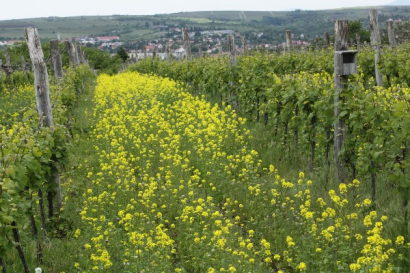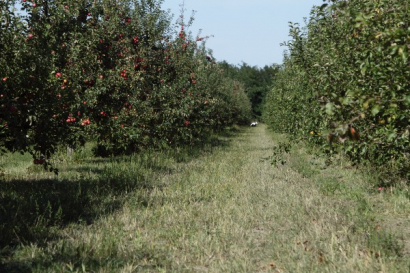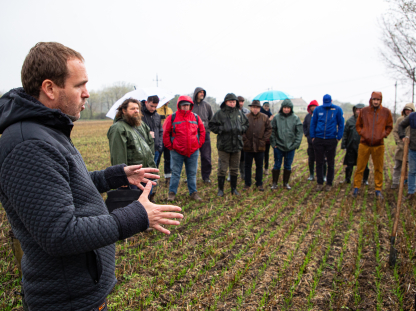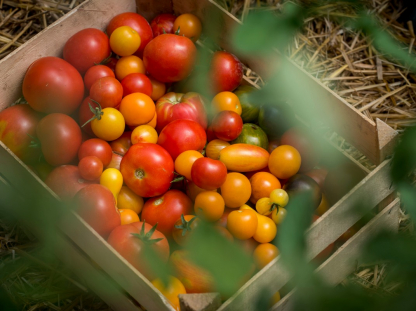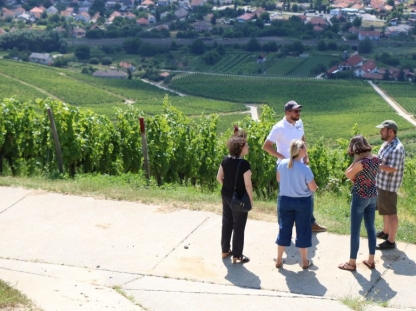Our research made understandable
Floral inter-rows in vineyards and orchards
Why is it important to attract as many useful living organisms as possible to monoculture production areas? How can we increase the biodiversity of these areas? What is the effect on soil and yield of species-rich planting between rows? What mixtures of seed species have proven most effective? We seek to answer these questions in our experiments below.
Although orchards and vineyards make up only about 3% of arable land in Hungary, they are usually concentrated in particular regions, and thus have a significant impact on the local environment. As such, it is not uncommon for species-poor ‘biodiversity deserts’ to develop. If, while still prioritizing crop yield, we also create secondary habitats in these plantations, they can also play a role in conserving biodiversity. This can be accomplished primarily by inter-row planting, the creation of buffer strips, or the restoration of verges. By such means, these areas can themselves become home to valuable and useful flora and fauna. By connecting previously fragmented habitat patches, they can also function as green corridors, thus helping to restore the balance of the surrounding wildlife.
Tamás Miglécz, ÖMKi’s research project manager, is leading our experiments into inter-row sowing in vineyards and orchards. One such experiment is being conducted as part of the LIFE VineAdapt project, the main aim of which is to increase the biodiversity of vineyards with native species, in order to restore to vineyards as many ecosystem functions as possible.
We are carrying out surveys at a total of six locations across three years, in order to monitor the extent to which of certain ecosystem processes are present. We assess the effectiveness of plant colonization, the number of wild bees, and the numbers of individuals of some predator group. Mixtures of diverse flowering species provide an attractive habitat for beneficial organisms. Many predators (e.g. predatory mites, spiders, and ladybirds) can be beneficial to viticulture by helping to control pest populations.
As a part of the experiment, we are testing our ÖMKi living inter-row seed mix, which was developed as a result of our previous six-year research. Using this mixture, we are also testing another, even more diverse mixture, which includes an additional 13 flowering plant species. The more varied the mixture, the more useful living organisms we can bring into the area. For the sake of economy, we will select the most beneficial species across the three years of the experiment, which can then be included in a new seed mixture.
Our research in the MNVH (Hungarian National Rural Network) project is based on the further testing of the existing ÖMKi living inter-row seed mix. Phytosanitary and soil tests are performed at the experiment locations several times a year. We assess the most common grape diseases and pests occurring next to the planted row, and examine soil moisture and soil penetration resistance to assess the soil-loosening effect of the planted row.
In this research project, we have extended the testing of the seed mixture to orchard locations as well. For the second year running, we will study the performance of three seed mixtures in orchards (three apple orchards). One seed mixture was the ÖMKi living inter-row seed mix, the second was a commercially available green cover mix, and the third, diverse mixture used the ÖMKi seed mix as a base, but added the seeds of more than a dozen additional wildflower and grass species.
In the first year, we examined the colonization of the plants, the moisture and permeability of the soil, and the quantity and quality of the crop. This year, as in our LIFE VineAdapt experiment, we are expanding the experiment to survey useful organisms.
You can read more about the MNVH species-rich inter-row planting experiments here.
Click here for detailed information about the LIFE VineAdapt project.
